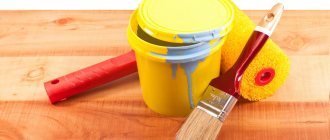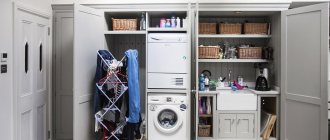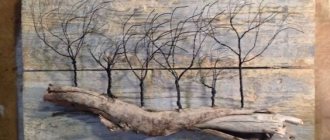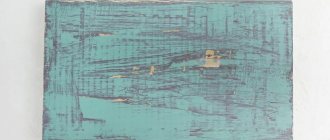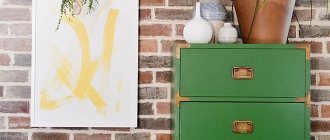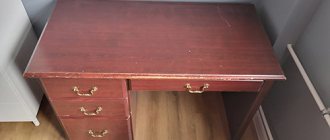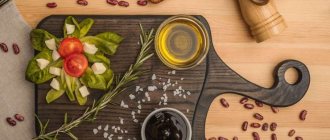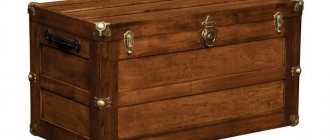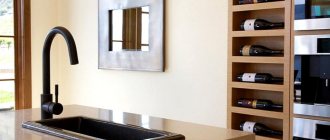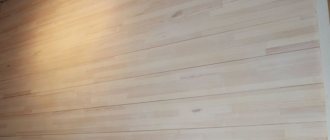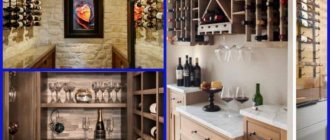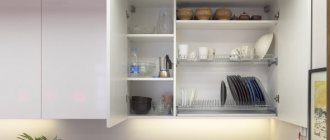Painting plywood is considered a necessary measure to protect the material from excessive moisture or other harmful environmental influences.
Currently, plywood is still often used in construction, especially private construction. It is made from thin sheets of veneer, which are glued together with adhesives of various compositions. It is used for the production of furniture, wall coverings, floors, as well as finishing the facades of buildings.
Why is plywood so popular? Durability and environmental friendliness are the main advantages of this type of building materials.
But it’s not enough to just purchase plywood and use it in its pure form for your needs. It is necessary to apply a number of measures thanks to which the plywood board can last a long time. And one of these measures is painting.
Let's look at each stage of painting plywood in more detail.
Paint selection
When deciding what to paint plywood with, it is important to keep in mind the expectations of the final result. You can simply do the staining. It will allow you to change the color of the veneer, make it darker, deeper and leave it that way. The procedure allows you to achieve the effect of using valuable wood species. Wood stain is an excellent antiseptic. It gives the base a matte look.
You can then varnish the stained surface. It will acquire a pleasant gloss. When interior design requires preserving the natural look of wood veneer, plywood products are simply varnished. In this design, the material looks noble.
If there is a need to completely hide the nature of the origin of the material, it is better to paint it completely, including the ends. The varnish can only be applied to a dry surface. Then it won't crack after drying. Urethane and polyurethane compounds are best suited for these purposes. They are more expensive than others, but they have increased strength characteristics.
Plywood coated with stain Source 1.bp.blogspot.com
Processing plywood before painting
Before painting, plywood must be completely cleaned of dust and small sawdust. Plywood sheets should be painted along the wood grain.
Do not forget that before preparing plywood for painting and staining, the sheet must dry thoroughly. Everyone knows the property of this material - to warp. You can avoid the risk of deformation by simply keeping the sheets in a dry room at room temperature for 3-4 days. This is especially true if the material was stored on the street or in a damp construction warehouse. Experts recommend not neglecting this stage and keeping the material for several days in the room where you then plan to paint it.
Initially, the sheet must be sanded to remove any irregularities. This stage can only be avoided if you purchase high-grade material. It's already quite high quality. For cheap varieties, sanding is highly desirable.
First, use coarse-grained sandpaper (No. 80-100), and then use medium-grained sandpaper (No. 100-120). This improves the subsequent adhesion of the surface to the paint. Do not forget to process the edges of the sheets; if they are too rough, they can be lightly planed and then sanded.
If you need to hide joints, fasteners or very noticeable defects, use putty. This material will also be useful to you if you decide to glue wallpaper onto plywood. Don't forget to sand the putty areas
After grinding is completed, the surface must be primed; most often, drying oil, primers with an alkyd base, or special compounds that fill the pores of the material are used for this.
For large volumes of work, it is recommended to use electric grinders. They will save time, make work easier and improve its quality.
What is a primer used for?
If finishing with plywood sheets is done indoors, then due to fluctuations in temperature and humidity, the wood texture may change: shrink and expand. The primer as an intermediate layer will not allow the applied paint to crack and will protect the base from moisture penetration and the formation of fungus. The primer is applied with a roller.
It is necessary to allow the soil to dry, and then additionally treat the plywood with antiseptics and fire retardants, which will enhance protection against fire and prevent blue stains from appearing. This is one of the important elements of the preparation process if you are going to paint plywood with transparent paint that has low resistance to bioaggressive manifestations.
Creation of various decorative coatings
Interior items are painted antique in loft style:
- After covering the base with primer and sanding, black dye is applied.
- The dried surface is treated with a second layer - light CM.
- The dried decorative coating is processed with coarse sandpaper.
- Varnishing is in progress.
Veranda, bathroom, covered with sheets, are additionally treated with antibacterial agents. After this, waterproof plywood paint is applied.
Beautiful tabletops are created: a pattern is applied to the painted base and varnished; Using an old bristle brush, an imitation of marble, plastic, or metal is created on the surface of the shield.
Practical advice
When painting plywood and subsequent use, you should follow the following recommendations.
- Rollers are often used for work. You should choose foam rollers, since fur rollers leave lint, which is very difficult to get rid of.
- If plywood is painted or varnished twice, it is important to ensure that the previous layer dries completely.
- Edges and curved elements are painted with a brush.
- Painted dry surfaces can be cleaned with soft sponges using soap compounds.
- Glossy surfaces are periodically wiped with a mixture of water, vinegar and lemon juice to restore shine.
- Do not use abrasives or hard brushes to clean painted plywood.
How to paint plywood
Painting plywood correctly is not difficult. We have already talked about applying paint according to the arrangement of the fibers. You can also take a completely traditional tool: a roller, sprayer or paint brush.
Let's consider in which case it is more appropriate to choose each of these options:
- Spray
Ideal for saving time and large amounts of space, such as floors, ceilings, facades;
- Roller
Convenient for painting medium-sized areas, such as a plywood cabinet, for example. As for the material of the roller coat, it is better to choose foam rubber for plywood;
- Paint brush
A universal tool that can be found in every home. Ideally paints hard-to-reach places (corners), ends and shaped elements.
Coloring
The layer is applied evenly to the surface, and it should be thin. Otherwise, you risk getting smudges, which will undoubtedly spoil the appearance. In addition, a thin coating gives the paint a richer color.
It is better to apply the paint in two successive layers. It is important to remember that the second one is always applied after the first one has completely dried.
Applying varnish
Sometimes varnish is used instead of paint. The plywood is first cleaned and sanded using sandpaper or a sanding machine, then it must be cleaned of any accumulated dust and degreased. Otherwise, all dirt will be visible under the varnish.
After applying the first layer of varnish, let it dry. Sand the first layer and then cover the surface with another layer. As a result of this approach, varnished plywood becomes dull.
If you want to get a glossy surface, you need to apply another layer of varnish on top. This time it is advisable to apply it using a sprayer to evenly distribute the varnish composition.
The nuances of painting white
To paint white or any other light color, you should add similar dyes to the primer, thereby achieving the required color concentration.
Are all steps necessary?
Most craftsmen, when processing large areas of plywood, greatly simplify the process, limiting themselves to sanding, priming and subsequent painting. Putty is used only in case of major damage. Preparation of the plywood base before painting ensures:
- additional strength;
- moisture resistance;
- beautiful smooth surface;
- longer possibility of using the product.
In addition, putty and primer are cheap and significantly help reduce paint consumption. The plywood base is very porous, has many voids, and the soil will fill them. If there is no soil, then the voids will be filled with dye, which is more expensive and cannot greatly increase strength.
Briefly about the main thing
Knowing how to paint plywood correctly, you can be confident in the quality of the result. If all stages of the technology presented above are followed, after drying the surface acquires a protective layer, becoming perfectly smooth.
There are many paint options for coating plywood sheets. Their choice depends on the operating conditions of the surface. For example, if it is a street, then it is preferable to paint it with an alkyd material. Interior finishing is done using water-dispersion paints.
You should remember the importance of preparatory work, which requires special care. The further type of coating depends on the correctness of grinding, priming and putty.
Ratings 0
Recommendations for varnishing
When starting to process the canvas, you should take into account some nuances. To get a good result and avoid unpleasant consequences, you need to:
The composition should be applied evenly in the direction of the wood fibers
- when painting plywood with acrylic paint indoors, cover furniture and floors that cannot be treated with polyethylene;
- choose a suitable putty to match the pigment used;
- apply the composition evenly along the wooden fibers;
- do not allow the formation of too thick a layer of pigment, which leads to the appearance of smudges;
- apply the composition in two layers if you need to create a rich shade;
- Use masking tape when combining different colors.
Features of painting work with plywood sheets
Paint and varnish coatings are reluctant to apply to plywood, which is due to the uneven surface. This applies to a greater extent to materials that have undergone rough factory processing.
Therefore, preparatory activities occupy a special place in this matter. It is not recommended to apply the composition directly to a wood base, as there is a risk of getting a defective coating with obvious defects. Even if you treat the surface with a thick layer, cracks and warping of the paint will appear in the future.
Therefore, painting plywood should be done in several layers, and the base coats are not decorative. They perform the functions of priming and leveling - that is, they prepare the base for applying a full-fledged decorative layer. In some cases, special mechanical processing of the sheets is required so that the primer itself can be laid on them.
Cleaning and sanding the material
When purchasing raw materials, you should pay attention to its texture: if it is very rough, the material must be cleaned and sanded. Before painting the plywood yourself, experts recommend drying it. Most likely, the sheets of material were sold from a warehouse, and it was often humid and damp there, so the wood could absorb some of the moisture. It is not possible to dry the product quickly, so the sheets of material are sent to a dry and warm place for 3 days.
With this tool you can sand small surfaces. If the sheets of material are large, it is better to use a power tool.
Once the plywood has dried, you can begin preparing it:
- Cleaning. This simple process is carried out to ensure that no large specks or contaminants remain on the surface of the raw material. Plywood can absorb moisture, so do not use water when cleaning. High-quality wood will always have a distinctive pattern - you also need to walk over it and check for contamination. Dirt must be removed using a coarse brush.
- Sanding. This procedure requires perseverance and care. Sanding consists of two stages: the first involves sanding with coarse-grain sandpaper, and the second with fine-grain sandpaper. The important thing here is to achieve not beauty, but a smooth surface. According to the advice of the masters, it is better to use a special grinding machine - this will speed up the work.
After passing coarse grain across the surface, it is necessary to change the nozzle to paper with fine dispersion. This procedure can easily be carried out manually, but it will take more time. Don't forget about the edges of the product - they also need to be cleaned and sanded.
Varnishing plywood
Causes
The need for painting is due to the following reasons:
- improving the aesthetic qualities of the material, since plywood after applying correctly selected paints and varnishes looks more attractive;
- ensuring additional resistance of the material to the negative effects of environmental factors.
Let's consider these points in more detail.
Wood-look varnish that emphasizes the depth of the grain pattern
No matter what the price of plywood, this material looks like a regular cut of wood. After applying varnish, the texture of the material stands out favorably, as the pattern of the fibers becomes deeper and more distinct.
If it is necessary that the finishing material does not look like wood, it can be covered with a continuous layer of paint. In this case, the texture will not stand out, and the plywood will look like the surface of drywall, concrete, plastic or other common building materials.
The presence of paint and varnish coating significantly increases the service life of plywood structures. A layer of paint or varnish prevents moisture from penetrating the structure of the lumber. As a result, plywood structures will not rot for a long time and will not crack due to periodic changes in humidity levels.
So, we have decided that applying paints and varnishes to the surface of lumber guarantees certain advantages. All that remains is to learn about what and how to paint plywood.
